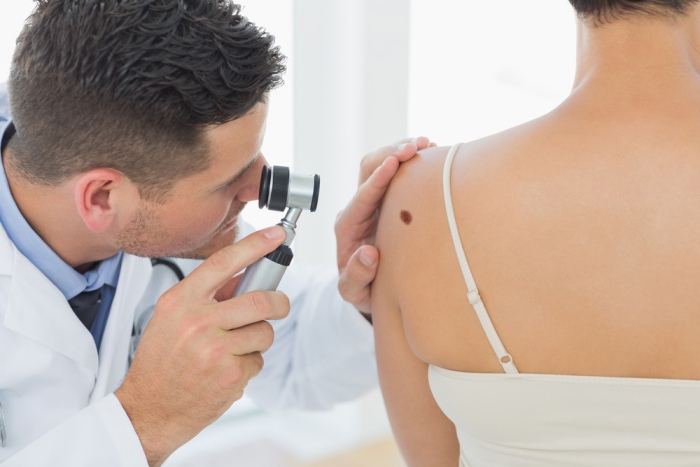
Survey finds people don’t know much about skin cancer
A major survey by the British Association of Dermatologists reveals that only one person in 25 checks their skin for signs of skin cancer once a month. Checking is recommended every four weeks to spot any skin cancers as soon as possible so they can be treated promptly.
“The survey also found that most people are generally not aware of what to look out for. Few people seem confident that they would be able to spot the signs of either melanoma skin cancer (the most aggressive form) or non-melanoma skin cancer,” explains Dr Conal Perrett, Consultant Dermatologist, The Devonshire Clinic.
Over 1000 people were interviewed for the study, which was published last week during Sun Awareness Week.
Worrying lack of skin cancer awareness
- Only 4% of people in Britain do not check their skin once a month. Around 6% of people look at their skin for signs of skin cancer once a year, but the British Association of Dermatologists warns this is not enough.
- Over three quarters of people said they would not know how to recognise a developing melanoma skin cancer. Over 80% said they would not know a non-melanoma skin cancer if they saw one.
- Almost 90% of those surveyed thought that skin cancer was no easier to remove than any other type of cancer.
Melanoma: what to look for
“Melanoma skin cancers often arise in a mole, so checking your moles regularly or having an expert mole check is a good idea, particularly if you have a lot of moles,” says Dr Perrett.
Signs to look for include:
- A mole that grows, becoming bigger in just a few weeks
- A mole that changes its colour, or develops several different colours
- A mole that alters in shape
- Any large moles – those over 7mm in diameter need to be checked by an expert
- Any moles that bleed or become sore or that weep fluid
- Any moles that hurt or become itchy
Mole checks at The Devonshire Clinic include digital mole mapping. A detailed photograph of the skin on every part of your body is taken and stored. We use advanced computer software to compare your current mole map with previous ones so that we can detect any changes in shape or size, or any new moles that have developed.
13,000 people are diagnosed with melanoma skin cancer in the UK each year. It can be highly aggressive, spreading quickly in the skin and then to the lymph nodes and other parts of the body. This type of skin cancer kills over 2000 people each year.
Non-melanoma skin cancer
This type of skin cancer is less likely to become invasive and spread through the body and is easily treated if caught early.
Signs to look for include:
- A sore patch of skin that doesn’t heal. This usually appears in a region of skin that is often exposed to the sun, but non-melanoma skin cancers can develop anywhere.
- A small lump in the skin. A basal cell carcinoma often looks red or pink but it can have a whitish centre, a bit like a small pearl. A squamous cell carcinoma is more likely to have a scaly or crusty surface.
- A lump that grows slowly but then ulcerates and becomes sore.
The link between skin cancer and the sun
“It is particularly worrying that this survey found that over 70% of people had been sunburnt at least once in the previous 12 months. Despite strenuous efforts to make people aware that even mild sunburn can damage the skin, increasing the risk of skin cancer, few people seem concerned,” notes Dr Perrett.
Although skin cancer is treatable when detected early, prevention is better. Using a good sunscreen whenever you go out in the sun, avoiding the strongest sun and covering up with a hat, long-sleeves and sunglasses are all recommended.
Treating skin cancer
Dr Conal Perrett is a leading expert in Mohs micrographic surgery, the gold standard technique that removes skin cancers layer by layer.
“Mohs surgery allows us to remove the cancer in its entirety. The cancer is removed layer by layer and we examine it under the microscope on the same day. It has the highest cure rate available and is associated with the lowest chance of recurrence. Furthermore, it is also tissue sparing, which means we only take the tissue we need, so it leaves less scarring than other surgical methods” he explains.
Dr Perrett stresses that all skin cancers are treatable if diagnosed early. Non-melanoma skin cancers can be removed safely and completely, with no impact on your future health. Melanomas may need more aggressive treatment but if they are removed before they have started to spread, survival rates are extremely high.
“Skin cancer is one of the most curable cancers – if we catch it early. I would encourage everyone to check their skin once a month and seek medical advice on any worrying signs. At The Devonshire Clinic we offer complete skin checks and mole screening to set your mind at rest.”
Contact us to make an appointment or to find out more…